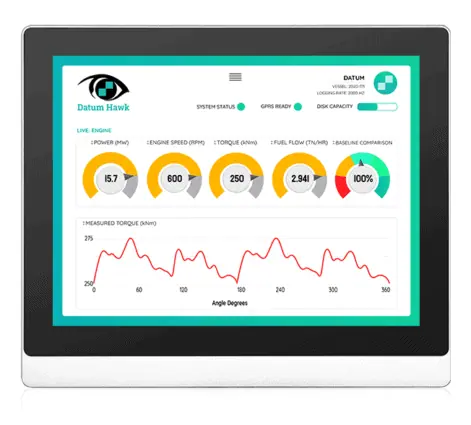After spending years, collaborating with Innovate UK & the University of Strathclyde on gathering data, running algorithms and profiling diesel generators, as well as many months of design, development and testing, Datum Electronics is ready to announce its revolutionary AI-enabled condition monitoring technology, aimed at improving fuel efficiency and reducing maintenance & operational costs.
Datum Hawk is the future if condition monitoring, offering real time analysis into power output, engine speed, torque, fuel flow, SFOC, and much more. At 2,000 samples per second, the system can detect problems quickly and display valuable information for each cylinder of the engine separately, providing you with the up to date status of your engine. By incorporating AI self-adaptive algorithms, Datum Hawk is designed to greatly improve your engine’s lifespan and longevity.
“What sets us apart is our focus on torsional vibration, which is the most accurate and reliable, and cost-effective method of condition monitoring.”, said Mark Gladdis, Business Development Manager of Datum Electronics. “Listening to the needs of our marine customers, we decided to bring in the most advanced condition monitoring technology with high sampling rate to make it possible to profile each individual cylinder of an engine or diesel generator for its own profile signature and identifying specific changes within them.”
The most recent push for green initiatives such as the EU Green deal, the UK’s clean maritime plan, as well as the possible introduction of further measures in the IMO’s agenda, in addition to the global economy’s volatility, constitute a targeted bottom-up approach to making savings foe marine industry essential. In response, we are required to create a new level of informed decision making, based on deep insight and operational management of the internal combustion engines employed in the shipping industry. This can be achieved by condition based maintenance, which monitors specific parameters. When the latter ones are analysed, they provide the ability for informed decision making, optimising service intervals, reduces down time, and makes for more efficient and compliant engines.
Amongst the most critical parameters suitable for continuous measurement is the instantaneous crankshaft torque. This a highly reliable and easily obtainable measurement that, when analysed, can provide insights regarding the degradation of components such a fuel injectors, cylinder liner and piston rings, and correspond those conditions to specific cylinders. The key to extracting information from this measurement is by understanding crankshaft dynamics, and the relationship between the in-cylinder pressure and the measured instantaneous crankshaft torque recorded at the flywheel.
“Everything that is happening in the engine is reflected by instantaneous torque. That means that with one simple measurement, Datum Hawk is capable of extracting the information about engine components without the need of measuring the pressure in an individual cylinder. This provides an advantage of being able to identify the errors early, making maintenance significantly cheaper”, explained Dr. Gerasimos Theotokatos, DNV GL Reader on Safety of Marine Systems at Maritime Safety Research Centre (MSRC) of the Department of Naval Architecture, Ocean & Marine Engineering at the University of Strathclyde.
Coupled with theDatum Shaft Power Meter, Datum Hawk represents the ultimate torque sensor system for real-time condition-based ship monitoring, allowing for sharply-focused preventative maintenance, thereby providing savings of both time and money.













